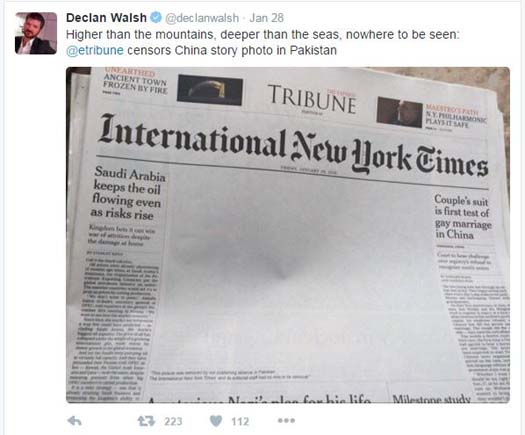Chancellor Angela Merkel of Germany of Germany was right there next to the president of France of Sunday, marching through the streets of Paris for all the world to see — all the world, that is, except for the readers of an ultra-Orthodox newspaper in Israel…“It is rather embarrassing when, at a time that the Western world is rallying against the manifestations of religious extremism, our extremists manage to take the stage,” Allison Kaplan Sommer commented on a blog for Israel’s left-leaning newspapers Haaretz. She berated HaMevaser for “denying the fact that in the wider world, beyond the ultra-Orthodox Jewish community, women do stand on the world stage and shape events.”Apparently deleted along with Ms. Merkel were: the mayor of Paris, Anne Hidalgo; a European Union official; and Simonetta Sommaruga, the president of Switzerland.The altered photo, first pointed out by Walla, an Israeli news site, drew wide scrutiny. Rather than just blur the women’s faces, HaMevaser tried to make it appear as though no women had been there to begin with. The results were far from seamless: Mediaite called the alterations “sloppy,” citing the discoloration of a man’s face, a disembodied hand, a mysterious glove and an unexplained blur, and posted a comparison with the unaltered image.

As in many Islamic countries, it’s common to see young men walking down the streets here in Pakistan holding hands or warmly greeting each other with a hug. But on Friday, the local publisher of the International New York Times decided a photograph of a man in China giving his boyfriend a kiss on the cheek was too graphic for Pakistani readers.
For the second time this month, Pakistan’s Express Tribune, which partners with and publishes the international edition of the New York Times locally, censored a front-page article or photograph. Instead of running the photograph, New York Times subscribers in Pakistan woke up to find a huge blank space on their paper.
“This picture was removed by our publishing alliance in Pakistan,” a caption stated below the 8-inch by 12-inch blank space. “The International New York Times and its editorial staff had no role in its removal.”
The photograph was supposed to accompany a Times story, written by Edward Wong and Vanessa Piao, about a first-of-its kind lawsuit in China challenging that country’s prohibition on same-sex marriage.

“The decision to censor the story [about the murder and silencing of Bangladeshi bloggers] was made by the local printer, an action that we certainly do not condone and that runs counter to our journalistic practices and values,” [said International New York Times editor Richard W. Stevenson].Stephen Dunbar-Johnson, INYT president, said that The Times is constantly reviewing its printing and distribution partnerships in places where this sort of censorship happens. A recent decision to withdraw from Thailand was based in part on censorship problems, he said. And in Pakistan, he said, there is no good alternative
to the current arrangement except no longer publishing there at all.Is there any recourse by The Times? It’s a difficult issue, Mr. Stevenson said. Those businesses “must operate in environments that are not always conducive to New York Times journalism.”…But, he emphasized, that The Times has no intention of pulling its punches in these regions: “We will never tailor our coverage to meet local standards or step back from our commitment to addressing head-on even the most sensitive subjects.”
In such instances, it’s good to have an alternative to offer readers. The story is readily available in digital form, and Mr. Stevenson said The Times tries to get that word out, both through social media and formal statements.
Nevertheless, the censorship is troubling. Even in the digital age, blank newspaper pages are a disturbing symbol of the lack of free expression in many parts of the world.
Rudoren’s piece fit into a well-established pattern at the New York Times of obsessing over Israeli-Jewish flaws, real and imagined, in a way glaringly disproportionate to how the newspaper deals with most other groups (even Americans).
